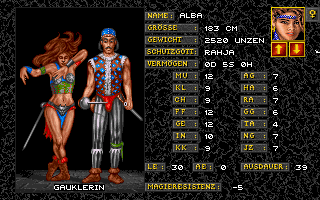Retro Replay Review
Gameplay
Realms of Arkania: Blade of Destiny places a heavy emphasis on party creation and character development. When you begin your adventure, you’ll generate a band of six adventurers drawn from a variety of archetypes that blend classic fantasy races with familiar role-playing classes. Each character boasts seven core attributes—strength, wisdom, dexterity, and the like—augmented by “negative” traits such as phobias or tendencies toward greed or violence. This dual-attribute system goes beyond mere numbers, directly influencing how characters react in tense situations and shaping in-game decisions.
The world of Arkania unfolds through a pseudo-3D first-person perspective whenever you explore towns and dungeons. Rather than random on-screen encounters, hostile creatures are absent from the real-time environment; instead, every fight transports you to a dedicated isometric battle screen. Movement and navigation on that screen feel deliberate and tactical, with facing direction, elevation, and character posture all playing roles in the ebb and flow of combat.
Combat itself is turn-based, demanding careful positioning and strategic use of each character’s specialized skills—be it melee weapon proficiency, archery, or even noncombat talents like deception and geography knowledge. You’ll find that a tactically sound flank attack or a well-timed defensive stance can turn the tide of battle just as surely as a critical sword strike.
Beyond fighting, survival mechanics introduce hunger, fatigue, and disease into your planning. When journeying across the 2D overworld map in search of the legendary Blade of Destiny, your party must carry sufficient provisions and rest strategically. With only two in-game years to thwart the Orcish invasion, resource management and route choices become as vital as your characters’ combat prowess.
Graphics
Released in the early ’90s, Blade of Destiny’s graphics reflect the era’s technological limits but still convey a strong sense of atmosphere. Towns and dungeons feature modestly detailed textures and tile-based walls rendered in a pseudo-3D that, while primitive by modern standards, effectively evokes cramped alleyways, dark corridors, and flickering torchlight.
On the battlefield, the game shifts to an isometric vantage, populating the grid with well-drawn sprites. Each combatant carries distinct visual cues—armor styles, weapon animations, and status effects—making it clear at a glance who’s healthy, poisoned, or lying prone. Animations are functional rather than flashy, but they serve the tactical clarity the game demands.
The 2D world map offers a broad overhead view of Arkania’s landscape, peppered with icons for towns, forests, and other points of interest. While simplistic, this map excels at providing a sense of scale and facilitating efficient route-planning. Menus and status screens lean toward text-heavy layouts, but they remain logically organized once you’re accustomed to the interface.
Despite its dated visuals, Blade of Destiny maintains visual cohesion throughout. The consistent art style and restrained color palette help sustain immersion, and the black-bordered windows that frame dialogues and combat encounters reinforce the feeling that you’re delving into an old, leather-bound tome of high adventure.
Story
The narrative thrust of Blade of Destiny is clear and compelling: the scattered Orc tribes of northern Arkania have been forged into a single war machine, threatening human settlements with annihilation. As the orcs rally under a powerful chieftain, only Grimring—the Blade of Destiny—can turn the tide. Yet this legendary sword is lost, and its treasure map shattered into pieces across the realm.
You are commissioned by Hetman Tronde Torbensson, the staunch leader of Thorwal, to reunite the torn map fragments, locate the Blade of Destiny, and strike down the Orcish hierarchy. All of this must be achieved within the unforgiving span of two years. This ticking clock injects urgency into every decision, from which towns you visit first to how long you rest in the wilderness.
Along your quest, you’ll encounter a cast of NPCs who offer side-quests, rumors, and moral dilemmas. Your party’s unique blend of positive and negative attributes often triggers special dialogue options—an avaricious rogue might haggle more fiercely for better prices, while a character with a phobia of undead may freeze in the face of skeletal warriors. These personal traits deepen the narrative, making each playthrough a distinct experience based on your party’s composition.
Although the main plot is straightforward, the richness comes from exploration and incidental storytelling. Uncovering a ruined shrine or discovering a reclusive hermit’s journal can reveal hidden lore about the Orc tribes or the forging of Grimring itself. These narrative threads reward diligent adventurers and reinforce the world’s sense of history.
Overall Experience
Realms of Arkania: Blade of Destiny is a robust, old-school CRPG that demands patience, planning, and a willingness to engage deeply with its mechanics. The character creation system is likely the most intricate you’ll find in a game of this vintage, and the survival elements add a welcome layer of realism to your expedition through Arkania.
Newcomers may face a steep learning curve as they familiarize themselves with the interface, turn-based combat, and resource management. However, once you master these systems, the sense of accomplishment in outmaneuvering a fearsome Orc warband or piecing together a crucial map fragment is immensely satisfying. The time limit creates a genuine tension, forcing meaningful choices rather than allowing aimless wandering.
For those willing to embrace its deliberate pacing and dated presentation, Blade of Destiny offers impressive replay value. Different party builds, alternative routes to vital map fragments, and varied responses to in-game events ensure that no two adventures feel identical. Its old-world charm and depth of systems still resonate with fans of classic role-playing games.
Ultimately, Blade of Destiny is a rewarding journey into the roots of Western CRPG design. If you cherish detailed character management, tactical turn-based battles, and low-tech graphics that prioritize atmosphere over spectacle, this title remains a hidden gem worth seeking out.
 Retro Replay Retro Replay gaming reviews, news, emulation, geek stuff and more!
Retro Replay Retro Replay gaming reviews, news, emulation, geek stuff and more!









Reviews
There are no reviews yet.